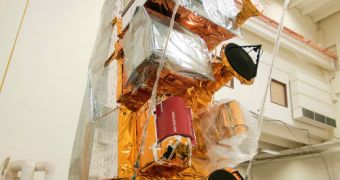NASA officials announce today, May 24, that the NASA National Polar-orbiting Operational Environmental Satellite System (NPOESS) Preparatory Project (NPP) climate and weather satellite has successfully finished is flight environmental testing stage. This brings it one step closer to completion.
The spacecraft, which is now located at a production and test facility in Boulder, Colorado, recently concluded the last stage of these assessments, the thermal vacuum test. The satellite is being constructed by Ball Aerospace & Technologies Corporation (Ball Aerospace).
The purpose of the two-month-long tests was to determine whether the NPP can really operate proficiently in space. Following the successful conclusion of this stage in the project, the satellite is now ready for delivery to the Vandenberg Air Force Base in Lompoc, California.
Once at the VAFB, the spacecraft will undergo final preparations and testing ahead of a planned, October 25 launch. It will bridge the gap between existing and future Earth-monitoring capabilities for the United States.
The current generation of Earth-observing satellites is called the Earth Observing System (EOS). NPP will link it to the future Joint Polar Satellite System (JPSS), which will be managed by the US National Oceanic and Atmospheric Administration (NOAA).
“I am very proud of the entire NPP satellite team for successfully conducting a very thorough and complex environmental test program,” says the NPP project manager Ken Schwer.
“The satellite performed very well and the teamwork during thermal vacuum testing was outstanding,” adds the official, who holds an appointment at the NASA Goddard Space Flight Center (GSFC), in Greenbelt, Maryland.
“Given the fact that the US has more severe weather than any other country, it’s crucial that decision makers have seamless data from the nation’s next weather satellite to protect the country’s economic stability,” explains Ball Aerospace official Cary Ludtke.
“This major milestone puts NPP a step closer to providing those continued observations,” adds the representative, who is the vice president and general manager of the corporation's Civil and Operational Space Business Unit.
The five instruments on NPP are the Visible/Infrared Imager Radiometer Suite (VIIRS), the Cross-track Infrared Sounder (CrIS), the Advanced Technology Microwave Sounder (ATMS), the Ozone Mapping and Profiler Suite (OMPS) and the Clouds and the Earth Radiant Energy System (CERES).
This satellite is based on Ball Corp.'s BCP 2000 spacecraft bus. The vehicle is being constructed under a contract the company signed with the NASA Goddard Space Flight Center (GSFC), in Greenbelt, Maryland.

 14 DAY TRIAL //
14 DAY TRIAL //